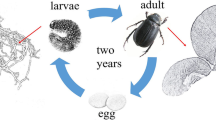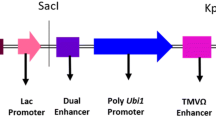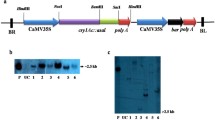Abstract
Key message
Overexpressing the Cry1Aa gene in sweetpotato significantly reduced pest damage through disrupting the integrity of the midgut of Spodoptera litura larvae for resistance against target Lepidoptera insect pests in sweetpotato.
Abstract
Sweetpotato is susceptible to insect pests and diseases leading to yield losses during pest outbreaks. Lepidoptera insects such as S litura are especially important pests of sweetpotato. The effect of Cry1Aa gene on S. litura was investigated by overexpressing Cry1Aa gene in sweetpotato to relieve symptoms due to pest damage. When transgenic leaves were fed to the larvae of S. litura, the growth of the larvae was reduced, the larval quality decreased, and mortality was increased compared with the larvae that fed on wild-type leaves. Further anatomical analysis revealed that the columnar cells of the midgut epithelium of the BT group were significantly damaged, loosened, or disordered. Furthermore, the integrity of the midgut was destroyed. In addition, when potted seedlings of the wild-type and BT sweetpotato were inoculated with the same number of S. litura larvae, wild-type plants died on the eighth day after infestation, while BT transgenic lines still grew normally. This study showed that transgenic sweetpotato overexpressing Cry1Aa can prevent S. litura infestation, and thus increase the yield of sweetpotato.






Similar content being viewed by others
Change history
29 November 2019
In Materials and method section, a sweetpotato variety “Taizhong-6” (China national number 2013003) should be renamed as Ayamurasaki”.
29 November 2019
In Materials and method section, a sweetpotato variety ���Taizhong-6��� (China national number 2013003) should be renamed as Ayamurasaki���.
Abbreviations
- ANOVA:
-
Analysis of variance
- FAA:
-
Formaldehyde alcohol acetic acid
- qRT-PCR:
-
Quantitative reverse transcription-polymerase chain reaction
- TUNEL:
-
Transferase dUTP nick end labeling
- WT:
-
Wild type
References
Abegunde OK, Mu TH, Chen JW, Deng FM (2013) Physicochemical characterization of sweetpotato starches popularly used in Chinese starch industry. Food Hydrocoll 33:169–177
Bernardi D, Salmeron E, Horikoshi RJ, Bernardi O, Dourado PM, Carvalho RA, Martinelli S, Head GP, Omoto C (2015) Cross-Resistance between Cry1 proteins in fall armyworm (Spodoptera frugiperda) may affect the durability of current pyramided BT maize hybrids in Brazil. PLoS One 10:130–140
Bravo A, Likitvivatanavong S, Gill SS, Soberón M (2011) Bacillus thuringiensis: a story of a successful bioinsecticide. Insect Biochem Mol Biol 41:423–431
Chalfant RB, Jansson RK, Seal DR (1990) Ecology and management of sweetpotato insects. Annu Rev Entomol 35:157–180
CIP Annual Report (2010) Putting strategy into action: implementing the CIP corporate and strategic plan to enhance pro-poor research impacts. International Potato Center, Lima
Deml R, Meise T, Dettner K (1999) Effects of Bacillus thuringiensis delta endotoxins on food utilization, growth and survival of phytophagous insects. J Appl Entomol 123:55–64
Deng C, Peng Q, Song F, Lereclus D (2014) Regulation of Cry gene expression in Bacillus thuringiensis. Toxins 6:2194–2209
Duan X, Xu J, Ling E, Zhang P (2013) Expression of Cry1Aa in cassava improves its insect resistance against Helicoverpa armigera. Plant Mol Biol 83:131–141
Hilbeck A, Defarge N, Bøhn T, Krautter M, Conradin C, Amiel C, Panoff JM, Trtikova M (2018) Impact of antibiotics on efficacy of Cry toxins produced in two different genetically modified BT maize varieties in two Lepidopteran Herbivore species, Ostrinia nubilalis and Spodoptera littoralis. Toxins (Basel) 10:489
Horikoshi RJ, Bernardi D, Bernardi O, Malaquias JB, Okuma DM, Miraldo LL, Amaral FSA, Omoto C (2016) Effective dominance of resistance of Spodoptera frugiperda to BT maize and cotton varieties: implications for resistance management. Sci Rep 6:34864
James C (2016) Global status of commercialized Biotech/GM Crops: 2016. ISAAA Brief No. 52. ISAAA, Ithaca, NY
Janmaat AF, Bergmann L, Ericsson J (2014) Effect of low levels of Bacillus thuringiensis exposure on the growth, food consumption and digestion efficiencies of Trichoplusia ni resistant and susceptible to BT. J Invertebr Pathol 119:32–39
Koo HN, Yun SH, Kim HK, Kim GH (2018) Elucidation of molecular expression associated with abnormal development and sterility caused by electron beam irradiation in Spodoptera litura (F.) (Lepidoptera: Noctuidae). Int J Radiat Biol 95:1–8
Livak KJ, Schmittgen TD (2001) Analysis of relative gene expression data using real-time quantitative PCR and the 2-DDCt method. Methods 25:402–408
Matten SR, Frederick RJ, Reynolds AH (2012) United States Environmental Protection Agency insect resistance management programs for plant-incorporated protectants and use of simulation modeling. In: Wozniak CA, McHughen A (eds) Regulation of agricultural biotechnology. Springer, New York, pp 175–267
Morán R, Garcıa R, López A, Zaldúa Z, Mena J, Garcıa M, Armas R, Somonte D, Rodrı́guezc J, Gómez M, Pimentel E (1998) Transgenic sweetpotato plants carrying the delta-endotoxin gene from Bacillus thuringiensis var. tenebrionis. Plant Sci 139:175–184
Muddanuru T, Polumetla AK, Maddukuri L, Mulpuri S (2019) Development and evaluation of transgenic castor (Ricinus communis L.) expressing the insecticidal protein Cry1Aa of Bacillus thuringiensis against lepidopteran insect pests. Crop Protect 119:113–125
Nathan SS, Chung PG, Murugan K (2005) Effect of biopesticides applied separately or together on nutritional indices of the rice leaffolder, Cnaphalocrocis medinalis. Phytoparasitica 33:187–195
Okonya J, Ocimati W, Nduwayezu A, Kantungeko D, Niko N, Blomme G, Legg JP, Kroschel J (2019) Farmer reported pest and disease impacts on root, tuber, and banana crops and livelihoods in Rwanda and Burundi. Sustainability 11:6–20
Ostlie KR, Hutchison WD, Hellmich RL (1997) BT-corn and European corn borer, long term success through resistance management. North Central Region Extension Publication 602, University of Minnesota, St. Paul
Prutz G, Dettner K (2005) Effects of various concentrations of Bacillus thuringiensis corn leaf material on food utilization by Chilo partellus larvae of different ages. Phytoparasitica 33:467–479
Santos-Amaya OF, Rodrigues JV, Souza TC, Tavares CS, Campos SO, Guedes RN, Pereira EJ (2015) Resistance to dual-gene BT maize in Spodoptera frugiperda: selection, inheritance, and cross-resistance to other transgenic events. Sci Rep 5:18243
Schnepf E, Crickmore N, Van Rie J, Lereclus D, Baum J, Feitelson J, Zeigler DR, Dean DH (1998) Bacillus thuringiensis and its pesticidal crystal proteins. Microbiol Mol Biol Rev 62:775–806
Schünemann R, Knaak N, Fiuza LM (2014) Mode of action and specificity of Bacillus thuringiensis toxins in the control of caterpillars and stink bugs in soybean culture. ISRN Microbiol 2014:135675
Suzuki N, Hori H, Tachibana M, Asano S (1994) Bacillus thuringiensis strain Buibui for control of cupreous chafer, Anomala cuprea (Coleoptera: Scarabaeidae), in turfgrass and sweetpotato. Biol Contr 4:361–365
Tabashnik BE, Brévault T, Carrière Y (2013) Insect resistance to BT crops: lessons from the first billion acres. Nat Biotechnol 31:510
Tanaka S, Yoshizawa Y, Sato R (2012) Response of midgut epithelial cells to Cry1Aa is toxin-dependent and depends on the interplay between toxic action and the host apoptotic response. FEBS J 279:1071–1079
Vachon V, Laprade R, Schwartz JL (2012) Current models of the mode of action of Bacillus thuringiensis insecticidal crystal proteins: a critical review. J Invertebr Pathol 111:1–12
Vinodh R (2013) Genetic transformation of sorghum for stem borer resistance using Cry1Aa gene via Agrobacterium-mediated approach. Ph.D Thesis, Andhra University, Visakhapatnam, India
Visarada KBRS, Padmaja PG, Saikishore N, Pashupatinath E, Royer M, Seetharama N, Patil JV (2014) Production and evaluation of transgenic sorghum for resistance to stem borer. Vitro Cell Dev Biol Plant 50:176–189
Visarada KBRS, Prasad GS, Royer M (2016) Genetic transformation and evaluation of two sweet sorghum genotypes for resistance to spotted stemborer, Chilo partellus (Swinhoe). Plant Biotechnol Rep 10:277–289
Whalon ME, Wingerd BA (2003) BT: mode of action and use. Arch Insect Biochem Physiol 54:200–211
Xue M, Pang YH, Li QL, Liu TX (2010) Effects of four host plants on susceptibility of Spodoptera litura (Lepidoptera: Noctuidae) larvae to five insecticides and activities of detoxification esterases. Pest Manag Sci 66:1273–1274
Yang J, Bi HP, Fan WJ, Zhang M, Wang HX, Zhang P (2011) Efficient embryogenic suspension culturing and rapid transformation of a range of elite genotypes of sweetpotato (Ipomoea batatas [L.] Lam.). Plant Sci 181:701–711
Yu H, Li Y, Li X, Romeis J, Wu K (2013) Expression of Cry1Ac in transgenic Bt soybean lines and their efficiency in controlling lepidopteran pests. Pest Manag Sci 69:1326–1333
Zhu C, Niu Y, Zhou Y, Guo J, Head GP, Price PA, Wen X, Huang F (2019) Survival and effective dominance level of a Cry1A.105/Cry2Ab2-dual gene resistant population of Spodoptera frugiperda (JE Smith) on common pyramided Bt corn traits. Crop Protect 115:84–91
Acknowledgements
This work was supported by the grants from the National Natural Science Foundation of China (31771854), China Scholarship Council (201804910055) and the National Key R&D Program of China (2018YFD1000700, 2018YFD1000705), The authors declare no conflict of interest.
Author information
Authors and Affiliations
Corresponding authors
Additional information
Communicated by Sang-Soo Kwak.
Publisher's Note
Springer Nature remains neutral with regard to jurisdictional claims in published maps and institutional affiliations.
Electronic supplementary material
Below is the link to the electronic supplementary material.
Rights and permissions
About this article
Cite this article
Zhong, Y., Ahmed, S., Deng, G. et al. Improved insect resistance against Spodoptera litura in transgenic sweetpotato by overexpressing Cry1Aa toxin. Plant Cell Rep 38, 1439–1448 (2019). https://doi.org/10.1007/s00299-019-02460-8
Received:
Accepted:
Published:
Issue Date:
DOI: https://doi.org/10.1007/s00299-019-02460-8




